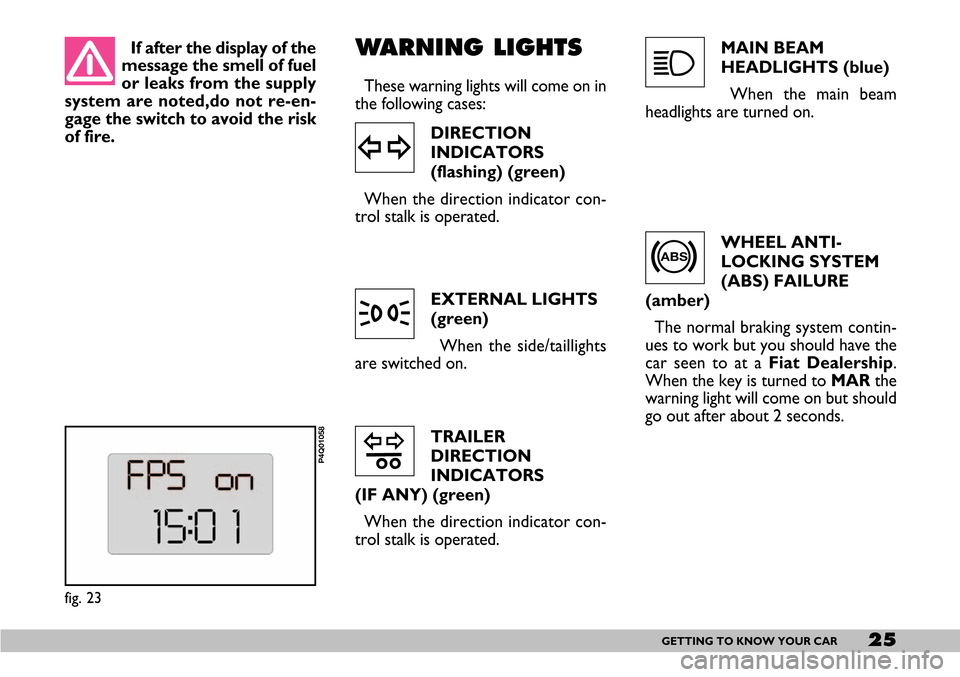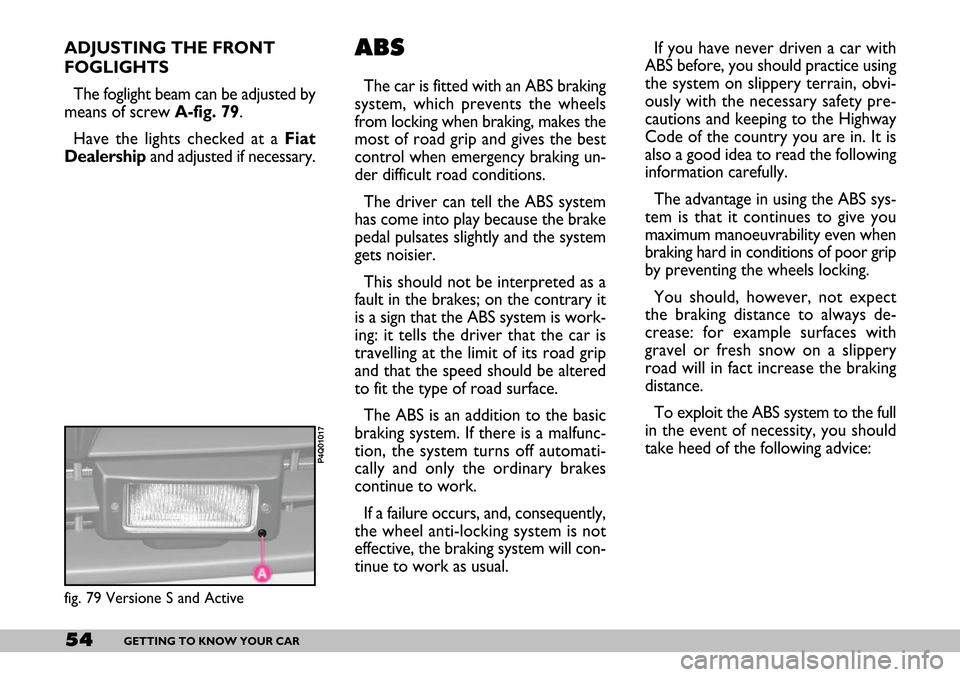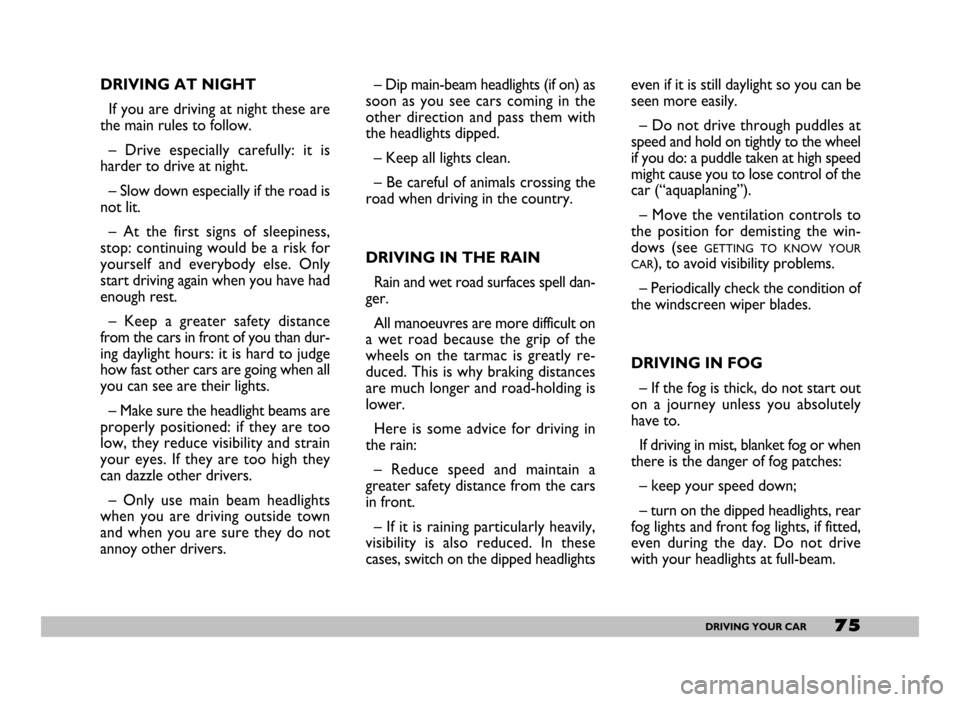low beam FIAT SEICENTO 2007 1.G Owners Manual
[x] Cancel search | Manufacturer: FIAT, Model Year: 2007, Model line: SEICENTO, Model: FIAT SEICENTO 2007 1.GPages: 154, PDF Size: 3.68 MB
Page 26 of 154

25GETTING TO KNOW YOUR CAR
If after the display of the
message the smell of fuel
or leaks from the supply
system are noted,do not re-en-
gage the switch to avoid the risk
of fire.
fig. 23
P4Q01058
WARNING LIGHTS
These warning lights will come on in
the following cases:
DIRECTION
INDICATORS
(flashing) (green)
When the direction indicator con-
trol stalk is operated.
EXTERNAL LIGHTS
(green)
When the side/taillights
are switched on.
TRAILER
DIRECTION
INDICATORS
(IF ANY) (green)
When the direction indicator con-
trol stalk is operated.
y
l
3
MAIN BEAM
HEADLIGHTS (blue)
When the main beam
headlights are turned on.
1
WHEEL ANTI-
LOCKING SYSTEM
(ABS) FAILURE
(amber)
The normal braking system contin-
ues to work but you should have the
car seen to at a Fiat Dealership.
When the key is turned to MAR the
warning light will come on but should
go out after about 2 seconds.
>
Page 51 of 154

50GETTING TO KNOW YOUR CAR
Heavy loads which are
not securely anchored
could seriously injure pas-
sengers in the event of an acci-
dent.
IMPORTANTCheck and adjust
the height of the dipped headlight
beam when travelling at night with a
rather heavy load in the boot (see
HEADLIGHTSin this chapter).
When refitting the rear
window shelf, fasten the
two side tie-rods fig. 67
passing them on the outside of
the struts.
Some versions are fitted with rear
speakers located on the rear window
shelf.
When removing the rear window
shelf disconnect also the connector
between speakers and sound system.
Proceed as follows: disconnect con-
nector A-fig. 73from its seat Blo-
cated on the side wall under the seat
belt hole. When refitting the rear window shelf,
reconnect connector to B-fig. 73to
reset speaker operation.
IMPORTANTProper radio oper-
ation is not impaired when the rear
speakers (on the rear window shelf)
are not connected.
fig. 73
P4Q01081
Page 55 of 154

54GETTING TO KNOW YOUR CAR
ADJUSTING THE FRONT
FOGLIGHTS
The foglight beam can be adjusted by
means of screw A-fig. 79.
Have the lights checked at a Fiat
Dealershipand adjusted if necessary. If you have never driven a car with
ABS before, you should practice using
the system on slippery terrain, obvi-
ously with the necessary safety pre-
cautions and keeping to the Highway
Code of the country you are in. It is
also a good idea to read the following
information carefully.
The advantage in using the ABS sys-
tem is that it continues to give you
maximum manoeuvrability even when
braking hard in conditions of poor grip
by preventing the wheels locking.
You should, however, not expect
the braking distance to always de-
crease: for example surfaces with
gravel or fresh snow on a slippery
road will in fact increase the braking
distance.
To exploit the ABS system to the full
in the event of necessity, you should
take heed of the following advice:ABS
The car is fitted with an ABS braking
system, which prevents the wheels
from locking when braking, makes the
most of road grip and gives the best
control when emergency braking un-
der difficult road conditions.
The driver can tell the ABS system
has come into play because the brake
pedal pulsates slightly and the system
gets noisier.
This should not be interpreted as a
fault in the brakes; on the contrary it
is a sign that the ABS system is work-
ing: it tells the driver that the car is
travelling at the limit of its road grip
and that the speed should be altered
to fit the type of road surface.
The ABS is an addition to the basic
braking system. If there is a malfunc-
tion, the system turns off automati-
cally and only the ordinary brakes
continue to work.
If a failure occurs, and, consequently,
the wheel anti-locking system is not
effective, the braking system will con-
tinue to work as usual.
fig. 79 Versione S and Active
P4Q01017
Page 76 of 154

75DRIVING YOUR CAR
DRIVING AT NIGHT
If you are driving at night these are
the main rules to follow.
– Drive especially carefully: it is
harder to drive at night.
– Slow down especially if the road is
not lit.
– At the first signs of sleepiness,
stop: continuing would be a risk for
yourself and everybody else. Only
start driving again when you have had
enough rest.
– Keep a greater safety distance
from the cars in front of you than dur-
ing daylight hours: it is hard to judge
how fast other cars are going when all
you can see are their lights.
– Make sure the headlight beams are
properly positioned: if they are too
low, they reduce visibility and strain
your eyes. If they are too high they
can dazzle other drivers.
– Only use main beam headlights
when you are driving outside town
and when you are sure they do not
annoy other drivers. – Dip main-beam headlights (if on) as
soon as you see cars coming in the
other direction and pass them with
the headlights dipped.
– Keep all lights clean.
– Be careful of animals crossing the
road when driving in the country.
DRIVING IN THE RAIN
Rain and wet road surfaces spell dan-
ger.
All manoeuvres are more difficult on
a wet road because the grip of the
wheels on the tarmac is greatly re-
duced. This is why braking distances
are much longer and road-holding is
lower.
Here is some advice for driving in
the rain:
– Reduce speed and maintain a
greater safety distance from the cars
in front.
– If it is raining particularly heavily,
visibility is also reduced. In these
cases, switch on the dipped headlightseven if it is still daylight so you can be
seen more easily.
– Do not drive through puddles at
speed and hold on tightly to the wheel
if you do: a puddle taken at high speed
might cause you to lose control of the
car (“aquaplaning”).
– Move the ventilation controls to
the position for demisting the win-
dows (see
GETTING TO KNOW YOUR
CAR
), to avoid visibility problems.
– Periodically check the condition of
the windscreen wiper blades.
DRIVING IN FOG
– If the fog is thick, do not start out
on a journey unless you absolutely
have to.
If driving in mist, blanket fog or when
there is the danger of fog patches:
– keep your speed down;
– turn on the dipped headlights, rear
fog lights and front fog lights, if fitted,
even during the day. Do not drive
with your headlights at full-beam.
Page 77 of 154

76DRIVING YOUR CAR
IMPORTANT On stretches of
road with good visibility, switch off
your rear fog lights; the brightness of
these lights could annoy the people
travelling in the cars behind
– Remember that fog also means the
tarmac is wet and therefore manoeu-
vres of all kinds are more difficult and
stopping distances are longer.
– Keep a good distance from the
cars in front of you.
– As far as possible, avoid spurts of
speed or sudden deceleration.
– Do not overtake other vehicles if
you can help it.
– If you are forced to stop your car
(breakdown, limited visibility etc.) try
to stop off the road. Turn on the haz-
ard lights and, if possible, the dipped-
beam headlights. Rhythmically sound
the horn if you realise another car is
coming.DRIVING IN
THE MOUNTAINS
– When driving downhill use the en-
gine braking effect by engaging a low
gear so as not to overheat the brakes.
– Under no circumstances should
you drive downhill with the engine off
or with the car in neutral, let alone
with the ignition key out.
– Drive at a moderate speed with-
out cutting corners.
– Remember that overtaking while
going uphill is slower and therefore
requires more free road. If you are
being overtaken while driving uphill,
make it easier for the other vehicle to
pass. DRIVING ON SNOW
AND ICE
Here are some tips for driving in
these conditions:
– keep your speed down;
– use chains if the roads are covered
in snow: see paragraph
SNOW TYRESin
this chapter;
– mainly use the braking effect of the
engine and under all circumstances
avoid braking sharply;
– when braking in a car not fitted
with ABS, reduce the possibility of the
wheels locking by varying the pressure
you exert on the brake pedal;
– do not accelerate suddenly and
avoid swerving;
– in the winter, even apparently dry
roads may have icy patches. Be care-
ful therefore when driving over
stretches that do not get much expo-
sure to the sun or are lined with trees
or rock where ice might not have
melted;
– keep a good distance from the ve-
hicles in front;
Page 95 of 154

94IN AN EMERGENCY
GENERAL INSTRUCTIONS
When a light is not working, check
that it has not fused before changing
the bulb.
For location of fuses, refer to
IF A
FUSE BLOWS
in this chapter.
Before replacing a bulb that does not
work, check that the contacts are not
oxidised.
Burnt-out bulbs must be replaced
with ones of the same type.
Always check the height of the head-
light beam after changing a bulb.
fig. 11
P4Q00160
IMPORTANTOn the inside sur-
face of the headlight there could ap-
pear a slight coat of fogging; this does
not show a defect, since it is a natural
occurrence due to low temperature
and to the degree of humidity in the
air; it will soon disappear as soon as
the lights are turned on. The presence
of drops inside the headlight shows
water seepage, refer to the Fiat
Dealership.